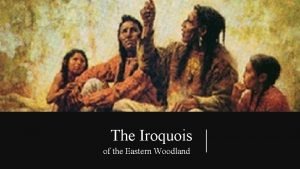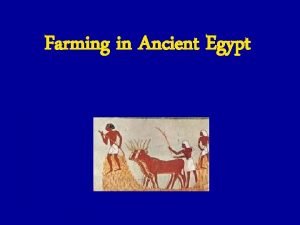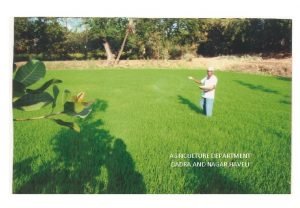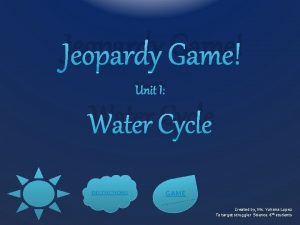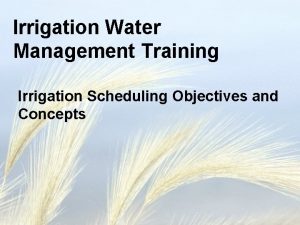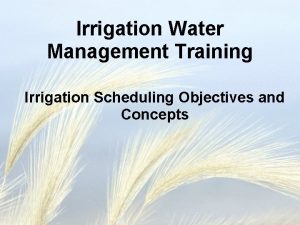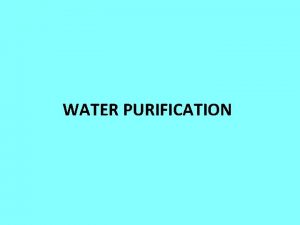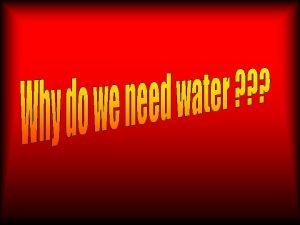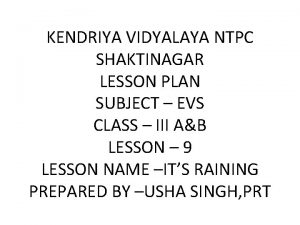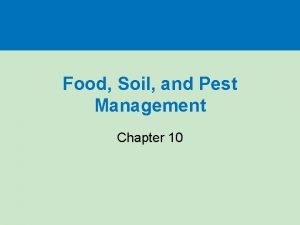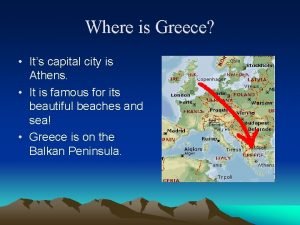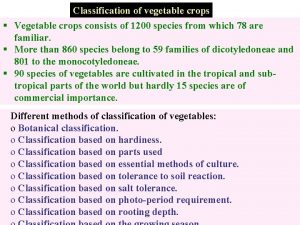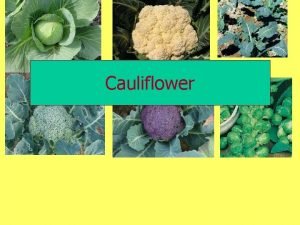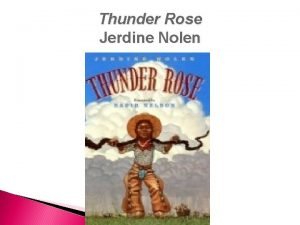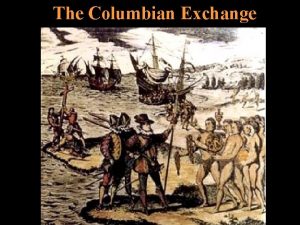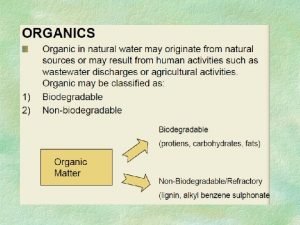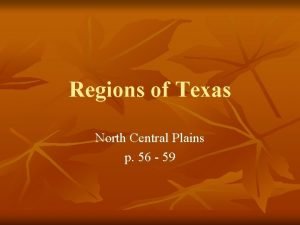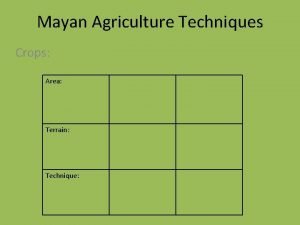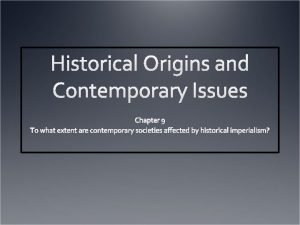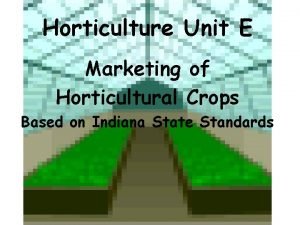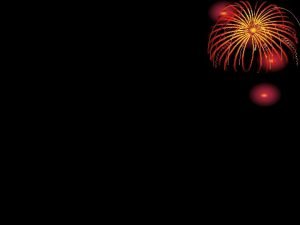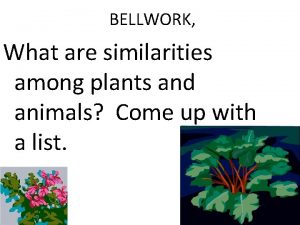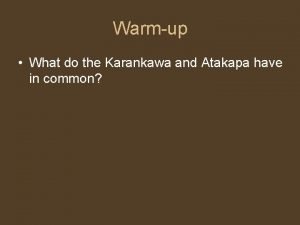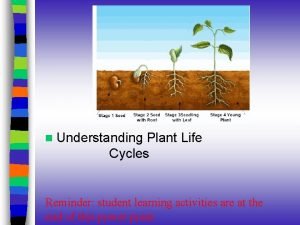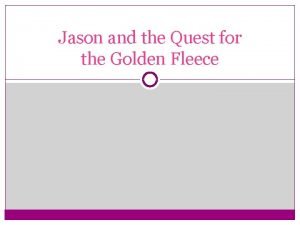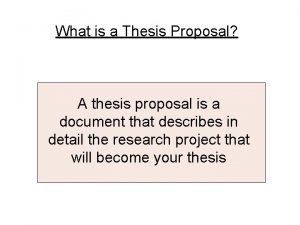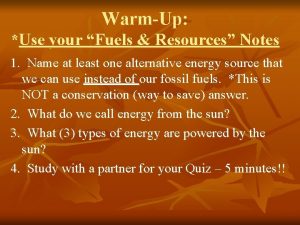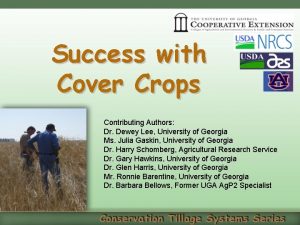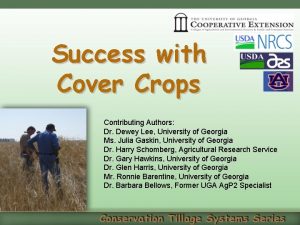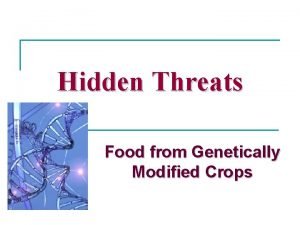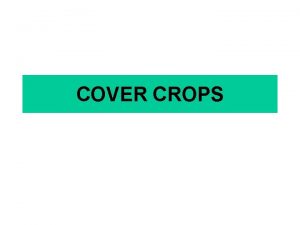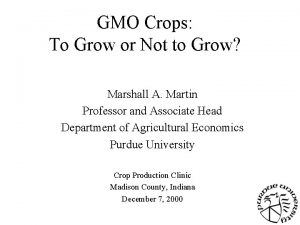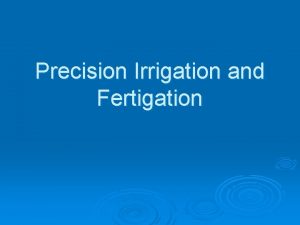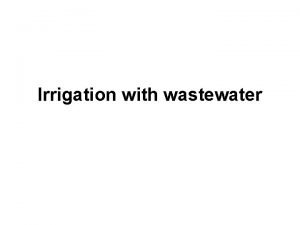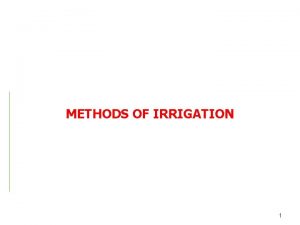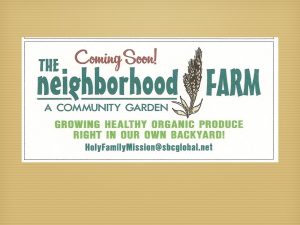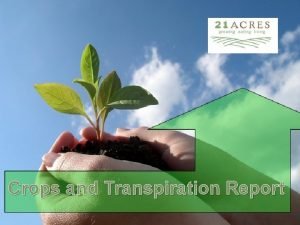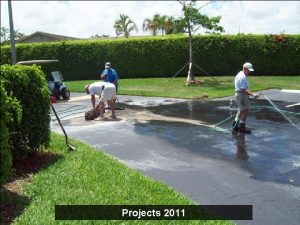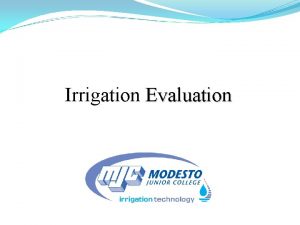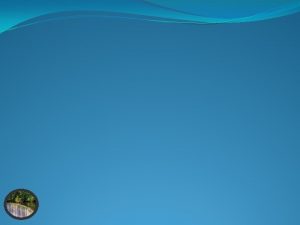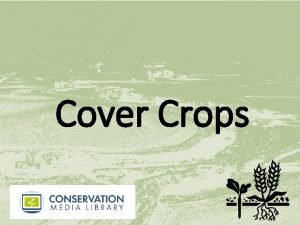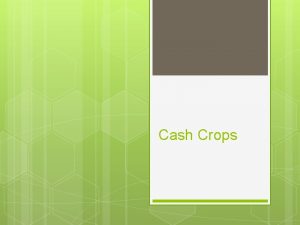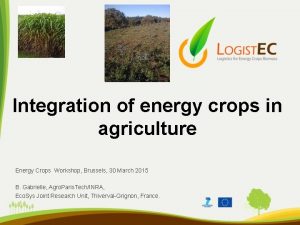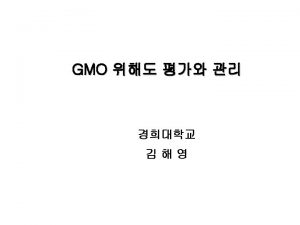Irrigation Irrigation Projects Crops need water to grow






































- Slides: 38

Irrigation

Irrigation Projects Crops need water to grow. They normally get the water when it rains. In places where there is little rainfall, irrigation is needed. Irrigation means pumping water from a river or lake to farmland. The water is then sprinkled over the crops. Q. Why is Irrigation common in the South of France and not in Ireland?

Case study – irrigation in France Languedoc has a Mediterranean climate with hot dry Summers and mild wet winters It WAS unsuitable for agriculture as the ground was too dry. The Canal Phillippe Larmour was built in the 60’s. It originates at the mouth of the Rhone river and extends along the coast branching into the valleys.



Positive effects Farmers diversified – wide variety of crops (cucumbers, olives, sunflowers, apricots). Farmers sell to tourists – businesses and profits grow. Wine making expanding – Languedoc now produces 1/3 of France’s wine. Languedoc now a wealthy region – farmed intensively Fastest growing agricultural region in France (one of Europe’s fastest).

Negative effects Salinisation of some areas – build up of mineral salts. It can lead to soil infertility. Pollution due to overuse of pesticides and fertiliser.

Desertification

Oil – A Non-Renewable Resource

Oil – A Non-Renewable Resource Our world uses vast amounts of energy. 25% of the population uses 85% of the earths resources. Oil is a non-renewable resource. It is finite Oil is a very important source of energy in our world today. It is called Black gold as it is one of the most valuable commodities in the world.

Uses of oil • Domestic • Industrial • Transport fuel

Advantages & disadvantages 1. It’s a clean fuel does not emit much smoke. 2. It’s efficient and gives off lots of energy. 3. Easy to transport pipeline or tanker 4. By-products include paint and plastics • Oil spills kill wildlife • It emits greenhouses gases when burned. • It is finite – will run out in 100 years. • The price fluctuates – it has a huge impact on economies.

Case study: Oil & gas in Ireland 1970’s Govt. granted licences to oil companies to search for oil in the Irish sea. The sea was divided into blocks, which are rented to gas companies. Test holes are drilled to see if there is enough oil or gas to bring ashore.

Irish “finds” • Waterford: Oil - Not enough to bring ashore. • Kinsale: Gas 1971, brought ashore by pipeline, sold to Bord Gais for distribution. In decline, smaller finds now being extracted. • Corrib: Gas. Mayo 1996. Could supply 60% of Ireland's needs. Huge controversy “shell to sea” campaign.


Countries with large oil reserves

Case study – Oil in Saudi Arabia Poor until 1930 – Bedouin nomads. 1938 oil discovered – oil industries created. Saudi became world’s largest exporter (owns 10%). Bedouin lifestyle replaced by huge wealth. Now – excellent standard of living (health, education infrastructure are very good) 1938


The future for oil in Saudi Oil is finite, Saudi Arabia has to plan for when it runs out. They are diversifying into other areas, such as telecommunications. They have joined the World Trade Organisation.

Culture in Saudi Arabia follows Islamic traditions, cultures and laws. Their culture id very different to ours. • Alcohol and pork are banned. • Unmarried men and women cannot be in public together. • Women must be fully covered in public • Women have limited social rights, they were granted the right to drive this year! • The majority of women do not work outside the home and often marry young. Saudi Arabia has ABSOLUTE MONARCHY – the King rules according to Islamic law.


Six things women in Saudi Arabia still can’t do http: //www. theweek. co. uk/60339/things-women-cant-do-in-saudi-arabia

Oil Producing Countries 1. Which country in the world produces the most oil? 2. Which country in the world uses the most oil? 3. Explain how an oil discovery in a country can be a positive thing. 4. Explain how an oil discovery in a country can be a negative thing.

The Real Price of Oil?

The Real Price of Oil?

Exploitation of Peat is a non-renewable resource which is found in Ireland. Peat is cut from bogs, either blanket bogs or raised bogs.

Blanket Bog Blanket bogs are found mainly in the western counties in Ireland. They are shallow bogs. Their average depth is 2. 6 metres.

Raised Bogs occur mainly in the central plain of Ireland. They are very deep bogs. Their depth can be over 8 -12

Cutting Turf: For about 1, 000 years turf has been cut by hand in Ireland using a peat spade called a Sleán.

Eco eye – for peat’s sake

Exploitation of Peat is exploited in 4 phases.

Bord na Mona Set up by government in 1946 to exploit peat commercially. Modern machinery helped speed up the process. Bord na mona mainly exploits RAISED bogs. Machinery A ditcher: Drains the bog, it has wide tracks to prevent sinking. A grader: Levels the surface of the bog Tractors lay light rail tracks which transport harvested peat out.


What is peat used for? Peat is mainly used for…? Why is it convenient for Ireland to use peat to generate electricity? What else is peat used for?

Sources of Electricity in Ireland What % of Ireland’s electricity was made from peat in 1978? What % of Ireland’s electricity was made from peat in 2002? List two forms of electricity production which have increased since 1978.

The Importance of Peat is very important to our economy. Bord na Mona employs 2000 people. Many of these jobs are in regions where job creation is difficult. Peat is used to generate electricity. Peat is exported to other EU countries.

Peat – What next? • Continue to exploit until it runs out. Saving money on imported fuels. • Preserve bogs in their natural state as a habitat for native plants and animals. • Promote as a tourist attraction for future generations • Bord na Mona plans to preserve 20, 000 hectares of raised bogs and return them to wetlands and as eco-park developments.

The future of cutaway bogs • Used to grow coniferous trees – timber products • Preserved as wetland habitats. • Used for wind farms. • Cutaway bogs are level and well drained, suitable for building and infrastructure.
 What type of food did the iroquois eat
What type of food did the iroquois eat What crops did egypt grow
What crops did egypt grow He never polishes his shoes so he never looks smart
He never polishes his shoes so he never looks smart Water and water and water water
Water and water and water water Agriculture of dadra and nagar haveli
Agriculture of dadra and nagar haveli Water cycle jeopardy
Water cycle jeopardy Objectives of irrigation water management
Objectives of irrigation water management Objectives of irrigation
Objectives of irrigation Need of water purification
Need of water purification We need to water
We need to water Kendriya vidyalaya lesson plan
Kendriya vidyalaya lesson plan Polyculture lessens the need for fertilizer and water.
Polyculture lessens the need for fertilizer and water. What is capital city of greece
What is capital city of greece Root vegetables name
Root vegetables name Physiological maturity of fruits and vegetables
Physiological maturity of fruits and vegetables Classes of vegetable
Classes of vegetable Cole crops definition
Cole crops definition My crops doing well
My crops doing well Pictures of food crops
Pictures of food crops Genetically modified crops
Genetically modified crops Crops
Crops What condition threatens peeta’s life?
What condition threatens peeta’s life? Important cities in central plains
Important cities in central plains Mayan agricultural techniques
Mayan agricultural techniques Mexican crops
Mexican crops Marketing of horticultural crops
Marketing of horticultural crops Golden crops foe
Golden crops foe Spatial arrangement of crops
Spatial arrangement of crops Warm season crops
Warm season crops The jumano built villages and grew crops near the
The jumano built villages and grew crops near the Nitrogen source in fermentation
Nitrogen source in fermentation Life cycle of a plant
Life cycle of a plant Catch crops examples
Catch crops examples Golden crops foe
Golden crops foe Expected results research proposal example
Expected results research proposal example Farmer plants different crops in a field each year
Farmer plants different crops in a field each year Cover crops
Cover crops Cover crops
Cover crops Genetically modified crops have
Genetically modified crops have
